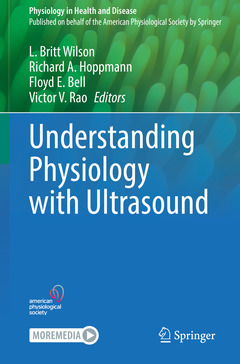Understanding Physiology with Ultrasound, 1st ed. 2022 Physiology in Health and Disease Series

This book will be of interest to anyone who wants to use ultrasound to understand human physiology both in the clinical setting and the classroom. Tremendous advances in ultrasound technology have resulted in portable ultrasound systems that are easy to use, produce excellent images, and are affordable with quality hand-held and laptop-sized systems costing between $2K and $20K. These systems are now being used at the patient bedside or point of care by almost all medical and surgical specialities from primary care to orthopaedic surgery. These portable systems, especially the hand-held devices, are now being called the stethoscopes of the 21st century and will likely be used by many that are presently using stethoscopes including physicians, nurses, physician assistants, medics and other health professionals.
Ultrasound began to be used in medical student education in the 1990s and is steadily becoming a common teaching tool for courses like anatomy and physiology. It is a visual, highly interactive learning tool that bridges the basic and clinical sciences and allows the learner to observe physiology principles in a living model. Ultrasound is also being used to teach other health professions students as well as undergraduate college students and high school students. Despite this interest there are no books available that provide an introduction to ultrasound and how it can be used to enhance the teaching of physiology. This e-book will do just that as well as offer ?How to Scan? videos with example laboratory exercises to further engage learners.
Dr. L. Britt Wilson is Professor of Physiology in the Department of Pharmacology, Physiology, and Neuroscience at the University of South Carolina School of Medicine in Columbia, SC. He received his PhD in physiology from Louisiana State University Medical Center in New Orleans, LA. Dr. Wilson did a postdoctoral fellowship in cardiology at the University of Texas, Southwestern Medical School in Dallas, TX. He has published numerous papers and book chapters on the neural control of the circulation as well as physiology education. He has been teaching physiology to a variety of health professionals, including fellows, and medical, graduate, nurse anesthesia, physician assistant, and nursing students for over 35 years. He has been a proud member of the American Physiological Society for over 35 years.
Richard A. Hoppmann MD, FACP, FAIUM is a Professor of Medicine and Dean Emeritus at the University of South Carolina School of Medicine Ultrasound Institute in Columbia, SC. Dr. Hoppmann earned his Doctor of Medicine degree at the Medical University of South Carolina, completed his internal medicine residency at East Carolina University School of Medicine, and completed his rheumatology fellowship at Wake Forest University Bowman-Gray School of Medicine. He is board certified in Internal Medicine and Rheumatology. In 2006, as Associate Dean of Medical Education, he introduced the nation's first integrated ultrasound curriculum (iUSC) across all four years of medical student education at the University of South Carolina School of Medicine -Columbia. Since that time, he has also helped develop a number of ultrasound training programs, including one for physician assistants and a primary care ultrasound fellowship. He is founder and served as the first President of the Society of Ultrasound in Medical Education (SUSME) which hosts and co-hosts a number of national and international ultrasound education meetings such as the World Congre
Provides an introduction to utrasound techniques and translates them into applications
Teaches practical ultrasound laboratory exercises, as well as clinical correlation cases
Discusses the necessary equipment to integrate ultrasound techniques into a physiology course
